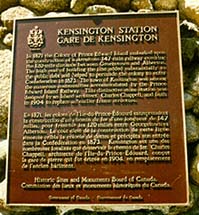








Soon
after assuming control of the P.E.I. railway
in 1873, the federal government contracted Thomas
Swinyard to survey the state of its newly-acquired Island
holdings. Swinyard was in for more than he bargained for,
as there were over 65 stations on the 147 mile route--
one every two and a half miles! In his report, he cites
Kensington as one of the twelve "way or
crossing" stations on the Island, a major stop and
switchyard along the line. The station itself is
described as a structure 42 feet long by 22 feet wide,
which featured a waiting room, ticket office, and
adequate freight storage. According to Swinyard, the only
facilities  conspicuous in their absence were the residence rooms for
the agent and his family. The lack of living space was
duly noted and, twenty years later, a second station was
built which met this building requirement. This
two-storey, mansard- roofed structure served as the
Kensington train station until 1905, when it was moved to
make room for yet another new building, the third in
thirty years.
conspicuous in their absence were the residence rooms for
the agent and his family. The lack of living space was
duly noted and, twenty years later, a second station was
built which met this building requirement. This
two-storey, mansard- roofed structure served as the
Kensington train station until 1905, when it was moved to
make room for yet another new building, the third in
thirty years.
Unlike its predecessors, the third Kensington railway station was obviously built with an eye to longevity. In its day, the building was widely recognized as one of the most elaborate stations in the province, a monument to the growing importance of Kensington in the Island rail system. Designed by C.R. Chappell and built by the local construction company, M.F. Schurman and Co., the building's frontage measured 68 x 28 feet and its final pricetag amounted to $5,000. Much of the cost-- and also the beauty-- of the edifice came from its striking exterior of New Brunswick stone. The grey fieldstone was arranged in the walls according to its natural shape and then embedded with stucco, making for a beautifully patterned and textured effect. Incidentally, the reason that Island redstone was not used is that-- due to its sandy composition-- it does not have the same durability as mainland rock. The impressive building was officially opened on December 20, 1905, with the typical round of speeches by Island politicians and railway superintendants. More enjoyable ceremonies took place later in the evening, as the building played host to a rousing evening of fiddle music and dancing.
The station interior received as much painstaking attention as the exterior. The office was beautifully panelled in North Caroline pine and ash, and the waiting rooms were also lined in ash. Waiting rooms were located at either end, one for women and one for men. As this was long before the days of women's rights, there was no smoking allowed in the so-called 'ladies section.' There is a story recounted locally about how, one day, a woman noticed that a man had come into the women's waiting room with a pipe in his mouth. She approached the wicket and, pointing to the non-smoking sign, asked the station man, "Mr. McMahon, do you allow smoking in here?" Caught in his double standard, McMahon paused, reflected, and then replied, "Yes ma'am, take out your pipe and smoke away." During the summer, though, most would wait outside on the platform where they could see the flower garden, where-- for years-- the town's name was displayed proudly in concrete letters. Other station facilities included the large 22 x 90 foot freight sheds and other trackside warehouses owned by such local firms as the Kennedy's, built to house their dry goods and produce while they awaited shipment.
Although Kensington's rail station was
finished several months before, the first passenger train
did not pass through until May 22, 1875, as heavy January
snowstorms
had forced the railway to close for the winter. While
nature often posed  obstacles to Kensington
trains, it was not long after passenger service began
that they faced another, more human problem: rowdiness.
Trips into Charlottetown for some liveliness and libation
were much-anticipated events, and sometimes, locals got
too much in the spirit of things before getting on the
train. The Daily Examiner
of October 13, 1877 recounts how fifteen fishermen
boarded at Kensington, "all worse for liquors,"
and started to brawl only minutes out of the station,
smashing in each other's noses and also a considerable
number of chairs, windows, and even stoves. When the
conductor could not halt the free-for-all, he simply
closed off the car and allowed them to finish what they
had started. Upon arrival in Charlottetown, the
played-out combatants were handed over the courts.
obstacles to Kensington
trains, it was not long after passenger service began
that they faced another, more human problem: rowdiness.
Trips into Charlottetown for some liveliness and libation
were much-anticipated events, and sometimes, locals got
too much in the spirit of things before getting on the
train. The Daily Examiner
of October 13, 1877 recounts how fifteen fishermen
boarded at Kensington, "all worse for liquors,"
and started to brawl only minutes out of the station,
smashing in each other's noses and also a considerable
number of chairs, windows, and even stoves. When the
conductor could not halt the free-for-all, he simply
closed off the car and allowed them to finish what they
had started. Upon arrival in Charlottetown, the
played-out combatants were handed over the courts.
But these disturbances were the exception rather than the rule, and the passenger service was a widely used and appreciated form of transportation on the island, particularly in the winter. One of the more popular trains that came through Kensington was the Summerside-bound 'Pig's Eye,' a phrase which referred to a mixed train that carried both passengers and freight. One variant on this expression was the rhyme 'Pig's Eye, at the back of the Y,' used to describe a mixed train caught at the junction-- or the 'Y'-- at Emerald. This 'Pig's Eye' train travelled in a full circle, starting at the ferries in Borden, passing through Emerald and Kensington, and then stopping in Summerside on its way back.
While the Kensington station was always admired by locals, the passengers passing through sometimes saw too much of it for their liking. In 1969, the Charlottetown Guardian quipped that "all trainmen must have liked Kensington because it seemed as if they never wanted to leave." The paper asked for an explanation to the "dark mystery" of why the Kensington stop never lasted less than a half-an-hour, leaving the passengers "sitting impatiently .. just itching to get home." It would be nice to think that trainmen could not tear themselves away from one of the Island's most beautiful station, but this editorial was also a sign of changing times. With the arrival of the automobile, which allowed everyone to come and go as soon as they wanted, people were no longer willing to wait out the delays the trains sometimes involved. The last passenger train on the Island rolled out on October 25, 1969, and the Kensington station was closed, as larger service centres took over.
 But the station did not
remain idle for long. In 1978, it was designated as a
National Historic Site, in recognition of its distinctive
architecture and significant role in Island railroading
history. The train station now houses the town library
and also a visitor's information bureau in the summer
months. And this beautiful station, one that author L. M.
Montgomery frequently travelled
through, has become a landmark for those who want to see
a station like those described in the pages of her famous
book, Anne of Green Gables.
But the station did not
remain idle for long. In 1978, it was designated as a
National Historic Site, in recognition of its distinctive
architecture and significant role in Island railroading
history. The train station now houses the town library
and also a visitor's information bureau in the summer
months. And this beautiful station, one that author L. M.
Montgomery frequently travelled
through, has become a landmark for those who want to see
a station like those described in the pages of her famous
book, Anne of Green Gables.
